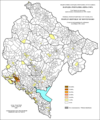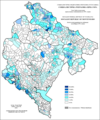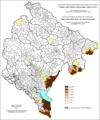
Demographic features of the population of Bosnia and Herzegovina include population density, ethnicity, education level, health of the populace, economic status, religious affiliations and other aspects of the population.
This article includes information on the demographic history of Kosovo.
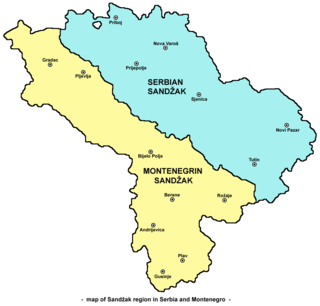
Sandžak is a historical and geo-political region in the Balkans, located in the southwestern part of Serbia and the eastern part of Montenegro. The Serbo-Croatian term Sandžak derives from the Sanjak of Novi Pazar, a former Ottoman administrative district founded in 1865.

Muslims is a designation for the ethnoreligious group of Serbo-Croatian-speaking Muslims of Slavic heritage, inhabiting mostly the territory of the former Socialist Federal Republic of Yugoslavia. The term, adopted in the 1971 Constitution of Yugoslavia, groups together several distinct South Slavic communities of Islamic ethnocultural tradition. Before 1993, a vast majority of present-day Bosniaks self-identified as ethnic Muslims, along with some smaller groups of different ethnicities, such as Gorani and Torbeši. This designation did not include Yugoslav non-Slavic Muslims, such as Albanians, Turks and some Romani people.
The population of the city of Sarajevo's four municipalities is 275,524, whereas the Sarajevo Canton population is estimated at 413,593.
Vojvodina's demographic history reflects its rich history and its former location at the border of the Ottoman and Habsburg empires and at the confluence of various peoples, making it a hotbed of invasion, colonization, and assimilation processes. Currently there are more than 25 ethnic groups living in Vojvodina and six official languages.

Demographic features of the population of Serbia include vital statistics, ethnicity, religious affiliations, education level, health of the populace, and other aspects of the population.
This article presents the demographic history of Serbia through census results. See Demographics of Serbia for a more detailed overview of the current demographics from 2011 census.

Demographic features of the population of Montenegro include population density, ethnicity, education level, health of the populace, economic status, religious affiliations and other aspects.

Rožaje is a town in Montenegro in the northern region.

This article is about the Demographic history of Bosnia and Herzegovina, and deals with the country's documented demographics over time. For an overview of the various ethnic groups and their historical development, see Ethnic groups in Bosnia and Herzegovina.
Albanisation is the spread of Albanian culture, people, and language, either by integration or assimilation. Diverse peoples were affected by Albanisation including peoples with different ethnic origins, such as Turks, Serbs, Croats, Circassians, Bosniaks, Greeks, Aromanians, Ashkali and Balkan Egyptians, Romani, Gorani, and Macedonians from all the regions of the Balkans.

The Socialist Republic of Montenegro, commonly referred to as Socialist Montenegro or simply Montenegro, was one of the six republics forming the Socialist Federal Republic of Yugoslavia and the nation state of the Montenegrins. It is a predecessor of the modern-day Montenegro.
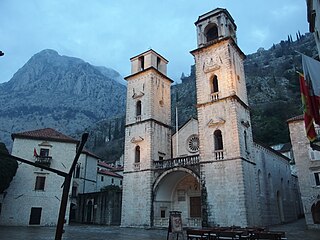
Eastern Orthodox Christianity is the largest religion in Montenegro at 71% of the population, and is the religion of choice for the vast majority of ethnic Montenegrins and Serbs. In addition to Eastern Orthodox Christianity, there is also a sizeable number of adherents to Sunni Islam at 20% of the population, mainly from ethnic Bosniaks and Albanians.
Serbs and Montenegrins (Serbs-Montenegrins) are an ethno-linguistic community in Albania. They are one of the recognized national minorities. The population was concentrated in the region of Vraka, but largely emigrated in the 1990s. The community is bilingual and by majority adhere to Eastern Orthodoxy, while a minority professes Islam. The majority of the Serbo-Montenegrin community came to Albania from Montenegro during the interwar Zogist period following 1926 and later from 1938 until 1948. In the latest census (2023) 511 citizens declared themselves as Montenegrins and 586 as Serbs.
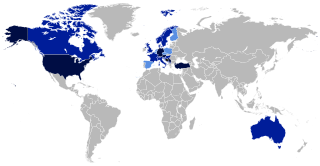
Bosnians are people native to the country of Bosnia and Herzegovina, especially the region of Bosnia. As a common demonym, the term Bosnians refers to all inhabitants/citizens of the country, regardless of any ethnic, cultural or religious affiliation. It can also be used as a designation for anyone who is descended from the region of Bosnia. Also, a Bosnian can be anyone who holds citizenship of the state of Bosnia and Herzegovina and thus is largely synonymous with the all-encompassing national demonym Bosnians and Herzegovinians.

Dolna Banjica is a village in the municipality of Gostivar, North Macedonia. Its FIPS code was MK27.
There are several points of dispute over the ethnic and linguistic identity of several communities in Montenegro, some of them related to identity of people who self-identify as ethnic Montenegrins, while some other identity issues are also related to communities of Serbs, Croats, Bosniaks and ethnic Muslims. All of those issues are mutually interconnected and highly politicized.

The Kosovo Agency of Statistics monitors various demographic features of the population of Kosovo, such as population density, ethnicity, education level, health of the populace, economic status, religious affiliations and other aspects of the population. Censuses, normally conducted at ten-year intervals, record the demographic characteristics of the population. The latest census started on 5th of April 2024 and according to the preliminary results, the Republic of Kosovo has 1,586,659 inhabitants, of which 795,046 are men (50.1%) and 791,614 are women (49.9%). The same year, US CIA World Factbook estimate put the country's population at 1,977,093. According to the first census conducted after the 2008 declaration of independence in 2011, the permanent population of Kosovo was 1,810,366.
Freedom of religion in Montenegro refers to the extent to which people in Montenegro are freely able to practice their religious beliefs, taking into account both government policies and societal attitudes toward religious groups. Montenegro's laws guarantee the freedom of religion and outlaw several forms of religious discrimination, as well as establishing that there is no state religion in Montenegro. The government provides some funding to religious groups.
















